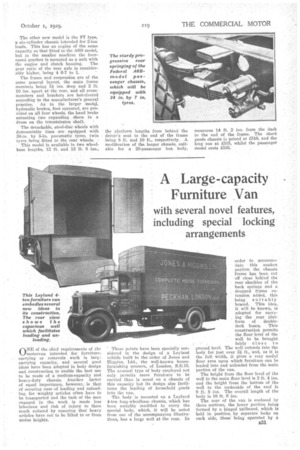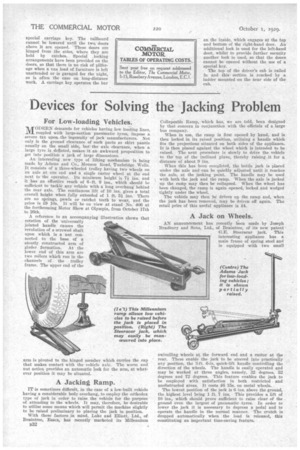A Large-capacity Furniture Van
Page 65

Page 66

If you've noticed an error in this article please click here to report it so we can fix it.
with several novel features, including special locking arrangements
This Leyland 4ton furniture van embodies several new ideas in its construction. The rear view shows the capacious well which facilitates loading and un loading.
ONE of the chief requirements of the motorvan intended for furniture, carrying or removals work is larp carrying capacity, and several good ideas have been adopted in body design and construction to enable the best use to be made of a medium-capacity and heavy-duty chassis. Another factor of equal importance, however, is that of securing ease of loading and unloading, for weighty articles often have to be transported and the task of the men engaged. in the work is made less laborious and risk of injury to them much reduced by ensuring that heavy articles have not to be lifted to or from undue heights.
These points have been specially considered in the design of a Leyland vehicle built to the order of Jones and Higgins, Ltd., the well-known housefurnishing concern, of London, S.E.15. The unusual type of body employed not only permits more furniture to be carried than is usual on a chassis of this capacity but its design also facilitates the loading of household goods into the van.
The body is mounted on a Leyland 4-ton long-wheelbase chassis, which has been suitably modified to carry the special body, which, it will be noted from one of the -accompanying illustrations, has a large well at the rear. In order to accommodate this sunken portion the chassis 'frame has been cut off close behind the rear shackles of the back springs and a -dropped frame extension added, this being suitably braced. This idea, it will be known, is adopted for carrying the rear platform of doubledeck buses. This construction permits the floor level of the well to be brought fairly close to
ground level. The well extends into the body for just over 31ft., and, as it is the full width, it gives a very useful floor area upon which furniture can be loaded into and unloaded from the main portion of the van.
The height from the floor level of the well to the main floor level is 2 ft. 4 ins. and the height from the bottom of the well to the underside of the roof is 9 ft. 8 ins. The overall length of the body is 16 ft. 6 ins.
The rear of the van is enclosed by three sections, the lower portion being formed by a hinged tailboard, which is held in position by separate locks on each side, these being operated by a special carriage key. The tailboard cannot be lowered until the two. doors above it are opened. 'These doors are hinged from the sides, where they are held by catches. Special locking arrangements have been provided on the doors, so that there is no risk of pilferage when a van load of furniture is left unattended or is garaged for the night, as is often the case on long-distance work. A carriage key operates the bar on the inside, which engages at the top and bottom of the right-hand door. An additional lock is used for the left-hand door, whilst to provide further security another lock is used, so that the doors cannot be opened without the use of a special key.
The top of the driver's cab is railed In and this section is reached by a ladder mounted on the near side of the cab.






















































































































